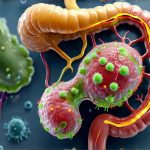The pursuit of lasting weight management often focuses on restrictive diets and rigorous exercise regimes, overlooking a critical component: the trillions of microorganisms residing within our digestive system – collectively known as the gut microbiota. For years, these microbial communities were largely ignored, but recent advancements in scientific understanding have unveiled their profound influence not only on digestion but also on metabolism, immunity, and even mental health. This intricate ecosystem plays a surprisingly pivotal role in determining an individual’s ability to achieve and maintain long-term weight stability, moving beyond simply losing weight to establishing a healthy relationship with food and body composition. Understanding the nuances of this connection is becoming increasingly crucial for developing effective, sustainable strategies for well-being.
Traditional approaches to weight loss often falter because they fail to address the underlying biological factors that contribute to weight regain. Dieting can disrupt the delicate balance of gut microbiota, potentially leading to a decrease in diversity and an increase in specific bacterial populations associated with increased energy harvest from food and inflammation. This creates a vicious cycle where dietary restrictions are followed by rebound weight gain, fueled by altered microbial activity. The emerging field of microbiome research offers a promising avenue for personalized nutrition and interventions aimed at cultivating a gut environment conducive to long-term health and stable weight management – one that recognizes the complex interplay between our bodies, the food we consume, and the microscopic world within us.
Gut Microbiota Diversity: A Cornerstone of Metabolic Health
The diversity of the gut microbiota is arguably its most important characteristic. A diverse microbiome, meaning a wide range of different bacterial species, generally equates to a more resilient and functional ecosystem. This resilience allows it to better withstand disruptions like antibiotic use, dietary changes, or stress, and perform its essential functions optimally. Individuals with higher microbial diversity tend to exhibit improved metabolic health markers – including better glucose control, reduced inflammation, and enhanced lipid metabolism. This isn’t simply about having a lot of bacteria; it’s about having the right kinds.
A less diverse gut microbiome is often associated with increased intestinal permeability (often referred to as “leaky gut”), where the barrier between the digestive tract and the bloodstream becomes compromised. This allows bacterial components and toxins to enter the circulation, triggering an immune response and chronic low-grade inflammation. Chronic inflammation is a significant contributor to insulin resistance, metabolic dysfunction, and ultimately, weight gain and difficulty losing weight. It also impacts satiety signals, potentially leading to overeating. Therefore, fostering microbial diversity can be seen as a proactive step towards establishing a healthier internal environment. Understanding the impact of gut health on overall wellbeing is key.
The composition of the gut microbiota isn’t static; it’s profoundly influenced by various factors including genetics, early life experiences (mode of birth, infant feeding), geographical location, and crucially, diet. Diets rich in processed foods, sugar, and saturated fats tend to decrease microbial diversity, whereas diets abundant in fiber-rich plant foods promote a more diverse and beneficial gut ecosystem. This highlights the power we have, through dietary choices, to shape our internal microbial landscape and influence long-term metabolic health. Gut biome diversity can be improved with a carefully curated diet.
The Role of Fiber in Cultivating Microbial Diversity
Fiber is often hailed as a cornerstone of healthy eating, but its impact extends far beyond simply promoting regularity. It’s the primary food source for many beneficial bacteria in the gut. When we consume fiber, it reaches the colon largely undigested and becomes fermented by these microbes, producing short-chain fatty acids (SCFAs) like butyrate, propionate, and acetate. These SCFAs are not merely waste products; they are potent signaling molecules that exert a wide range of health benefits.
Butyrate, in particular, is crucial for maintaining the integrity of the gut barrier, reducing inflammation, and even enhancing insulin sensitivity. Different types of fiber support different bacterial populations, contributing to overall microbial diversity. For example:
– Resistant starch found in cooked and cooled potatoes or rice feeds specific bacteria that produce butyrate.
– Inulin, present in onions, garlic, and leeks, supports Bifidobacteria which are associated with improved immune function.
– Pectin from fruits like apples and berries promotes a diverse range of beneficial microbes.
Increasing fiber intake gradually is essential to avoid digestive discomfort such as bloating or gas. It’s also important to stay adequately hydrated when increasing fiber consumption, as water aids in the fermentation process and prevents constipation. A gradual approach allows the gut microbiota to adapt and thrive on this new food source. Maintaining a healthy gut can reduce inflammation, which may be linked to autoimmune diseases.
Prebiotics vs Probiotics: Understanding the Difference
The terms prebiotics and probiotics are often used interchangeably, but they represent distinct approaches to influencing the gut microbiome. Probiotics are live microorganisms that, when consumed in adequate amounts, confer a health benefit to the host. They can be found in fermented foods like yogurt, kefir, sauerkraut, and kimchi, or taken as supplements. While probiotic supplementation can sometimes provide temporary benefits – such as alleviating digestive symptoms – their effects are often transient and strain-specific.
Prebiotics, on the other hand, are non-digestible fibers that serve as food for beneficial bacteria already residing in the gut. They essentially nourish and encourage the growth of existing microbes, promoting a more diverse and resilient ecosystem. Prebiotic sources include foods like garlic, onions, leeks, asparagus, bananas, and oats. Research suggests that prebiotics may have a longer-lasting impact on microbial composition than probiotics alone because they support the natural inhabitants of the gut.
A synergistic approach – combining both prebiotic and probiotic strategies – can be particularly effective for optimizing gut health. This is sometimes referred to as synbiotic therapy, where the combination enhances the survival and colonization of probiotic strains while simultaneously fostering a thriving microbial environment. However, it’s crucial to remember that individual responses to prebiotics and probiotics vary significantly. Poor gut biofilm can also impact the effectiveness of probiotics.
The Gut-Brain Axis and Weight Regulation
The gut isn’t isolated; it communicates extensively with the brain via what is known as the gut-brain axis. This bidirectional communication pathway involves neural, hormonal, and immune signaling mechanisms. The gut microbiota plays a critical role in this interplay, influencing brain function and behavior – including appetite regulation, mood, and stress response. Certain microbial metabolites produced during fiber fermentation, like SCFAs, can directly impact brain activity and neurotransmitter production.
Disruptions in the gut microbiome have been linked to altered reward pathways in the brain, potentially contributing to food cravings and impulsive eating behaviors. A less diverse gut microbiota may also lead to increased inflammation, which can impair cognitive function and decision-making related to food choices. Furthermore, imbalances in the gut microbiome can affect levels of hormones like ghrelin (the “hunger hormone”) and leptin (the “satiety hormone”), disrupting appetite regulation and promoting overeating.
Therefore, cultivating a healthy gut microbiota isn’t just about physical health; it’s also about supporting mental well-being and establishing a more mindful relationship with food. Strategies to improve gut health – such as dietary changes, stress management, and adequate sleep – can indirectly contribute to improved weight stability by influencing brain function and reducing impulsive eating behaviors. The connection between the gut microbiome and the brain is complex but increasingly recognized as a vital component of long-term weight management success. A healthy gut also plays a role in managing gut inflammation which can impact overall health. The relationship between gut microbiota and obesity is also an area of growing research. Finally, understanding the link between the gut microbiome and diabetes can help in preventative care.


















